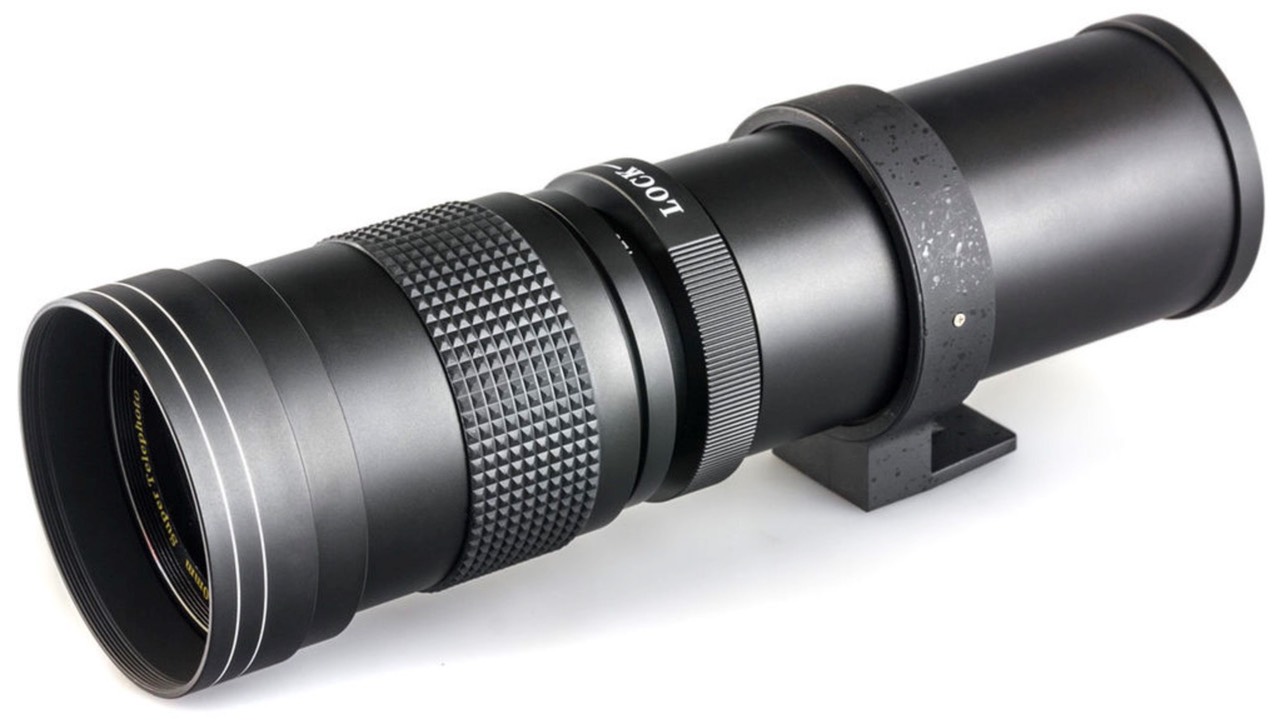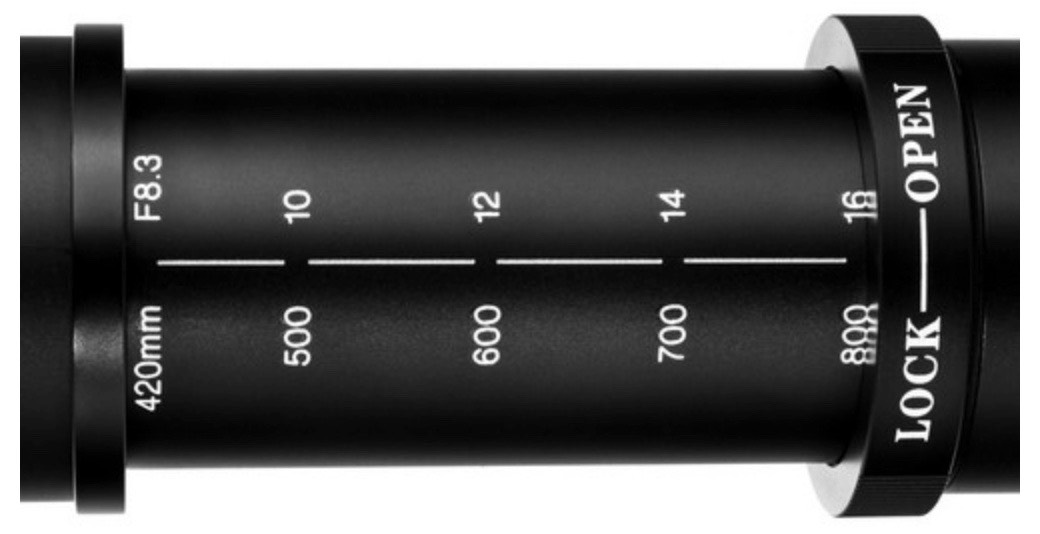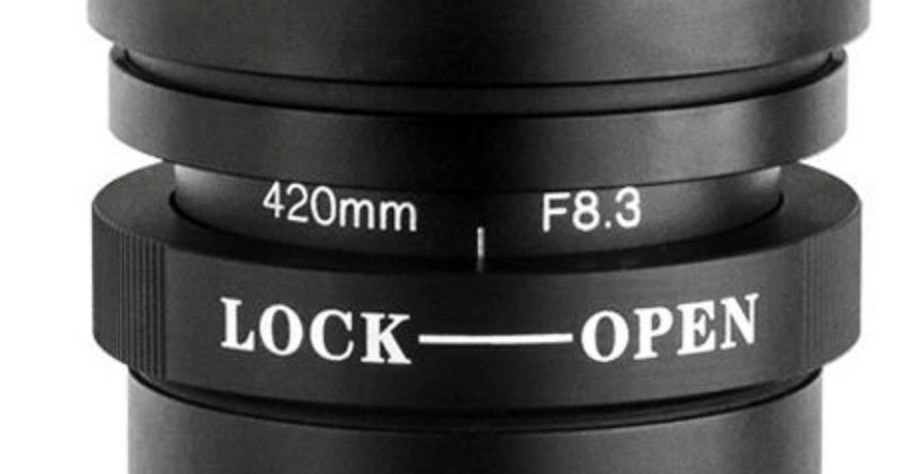
What is It?
Variations of this simple, low cost, manual focus, near apochromatic telephoto zoom lens date well back into the 80's, and they all use the old T2 mount, which requires adapters to mount the lens on a camera. That made these lenses a quick and dirty telephoto option for mirrorless cameras. From the vendor I ordered from, Opteka supplies both the Nikon F and Nikon Z mount adapter.
I'm not sure whether Opteka is just a new name for an old company, or whether they just took over an existing product line. Opteka has been around since just after the turn of the century supplying a variety of low-cost photographic supplies and lenses.
I've been wanting try one of these lenses for awhile now, and trying to round out the reviews on this Z System site gave me an excuse to do so.

The lens consists of a lightweight metal barrel in which 4 elements are mounted in 2 groups. Zooming is done by extending an inner barrel outward (see above photo), the old push/pull zoom design. The extension separates the two lens element groups, the focusing moves the forward group, which also extends the lens. Opteka claims the lens is multi-coated, and yes, it appears at least the front element is. Still, it's a dirt simple optical design overall.
At its longest, with the Z adapter mounted, the whole concoction checks in at a lengthy 15". It collapses down to something approaching 10" with the Z adapter mounted, and 8.7" without it. But it's a narrow barrel of only 2.7" (69mm), thus the lens takes 62mm filters! Note that the filter mount rotates during focus (but not zoom). A rotating tripod mount is permanently attached to the lens. Up front, the lens comes with the shortest screw-in lens hood you'll ever see for such a long telephoto lens (20mm, or less than an inch).
This is a fixed aperture lens, though zooming changes what that aperture is:
- 420mm — f/8.3
- 500mm — f/10
- 600mm — f/12
- 700mm — f/14
- 800mm — f/16
The lens has no electrical contacts, so you'll be using it on a Z system probably in Manual exposure mode and varying the shutter speed and ISO to get a proper image. If you're using the lens on a Z5/Z6/Z7, remember to set Non-CPU Lens Data, and then the sensor-VR will work correctly. The lens is also manual focus, so you'll want to turn focus peaking on and assign zoom to a button so you can quickly evaluate focus.
Included with the set I bought was a 2x teleconverter—which seems to be a simple metal barrel with two additional elements glued in the middle—plus pouches for the lens and for the teleconverter, two mounts (Nikon F and Nikon Z), lens caps, and even a lens cleaning cloth.
The lens sells for US$109 on Amazon, US$155 at B&H. There's no marking as to where the lens is made, but the teleconverter clearly identifies it as being made in China.
Source of the lens reviewed: purchased
How's it Handle?
Surprisingly, the build quality seems mostly good for such a low cost product. A light aircraft grade metal is used throughout, so the lens seems sturdy, and the design is simple enough that it would have been difficult to mess up the basic build.
That said, you'll see obvious screws, and the tripod collar tightener is really is just a screw with a knob on it. The supplied Z-mount adapter (T2 to Z) was solid as a rock and nicely made (it features a knurled mounting ring where they didn't really have to do that, and a hand-painted red alignment dot on the bayonet itself. Of the supplied parts, the teleconverter was clearly the shoddiest construction, and I wonder about the element alignment. If I were to truly start using this lens regularly, I might look to do a little extra black paint work on some of the inner barrel as the edges of the teleconverter elements mount, among other bits, looked like they could reflect. Fortunately, the design of everything is so simple and accessible that someone patient enough and handy with tools can actually manage that.
The focus ring seems mostly very smooth, though I could feel a bit of grittiness at one end of the rotations. The zoom push/pull is less smooth, feeling like a metal on metal slide, but it has no rocking to it, at all. There's a "locking ring" on the zoom barrel, but it's really more of a stiffening than a locking.

The tripod collar can freely rotate to any position and has no clicks for positioning. I suspect the set screw/knob might wear after time, but this might even be a user fixable issue.
The big issue you're going to have with this lens is keeping it composed on target and steady during the shot. Because it's a manual focus lens with no contacts, that sometimes makes using it seem like you need four hands.
How's it Perform?
You can't really do good chart testing with a lens this long, and your support setup is going to need to be absolutely locked down to rule out and camera/lens movement. Most of my observations here are not from test charts, though I did mount one a long way off and photograph it.
Sharpness: Central area is poor to what I might call fair, partly because diffraction is going to be an issue on the Z50 and Z7, particularly as you zoom in, and partly because this is a dirt simple lens with simple glass. On a Z6 the lens might almost hit the lowest level of good at 400mm in the central region with a front lit subject and you truly nailing the focus, but I'm going to stick with poor to fair call. The corners don't quite live up to the center on FX bodies. The overall optics impression is "okay, but..."
One problem is that for the things you're going to be using this lens, the depth of field is so narrow—despite the small aperture—that any miss of focus hurts, and the angle of view is so small at 800mm that any unsteadiness in the platform or shutter shock hurts even more. Still, a little work at keeping the lens steady coupled with a bit of judicious post processing nets you a reasonable result much of the time.
Chromatic Aberration: Very visible on high contrast edges. You'll always want to be correcting lateral CA.
Vignetting: On DX cameras, as I was mostly testing this lens with—you're really buying this lens for reach, right?—vignetting is low. On FX, the corners will go softer and darker to the point where you'll want to correct them or crop.
Flare: Okay, now we're going to hit one of the big weaknesses of the lens: it has considerable veiling flare, and particularly when shooting into backlight. Let me show you a sort of worst case with this lens:
Oh dear. This bird is sitting with the sun behind it (just off frame right) and I intentionally underexposed a bit seeing if I could bring in some sky (I couldn't). We're more than 75 feet from the bird, it fills only a quarter of the frame, and I'm shooting a Z50 at ISO 800. You can see all the purple CA, and it appears there is no real bird there, just an outline. Okay, with a little Photoshop I get:

I was a little surprised to pull this much out of this image. Detail is smudged by diffraction and noise, but still, this attests to the Z50's raw files and the fact this little tele zoom doesn't add many terrible complications. Dehaze and some lowering of the Highlights are your friends when it comes to the veiling flare. From there, you'll still have quite a bit of work to do, though. Note that none of that post processing brought back feather detail: it's been diffracted out of the picture.
Bokeh: Bet you didn't expect me to cover that, did you? Well, because you're often working with no depth of field, even with these small apertures, guess what? You can get lots of bokeh balls.
This is just the upper left quadrant of an image (you can see a bit of the bushes where my subject/focus was). Definitely bright edge ringing coupled with some bright center, but not particularly objectionable. Moreover, almost no cat eye effect in the corner. Depending upon how out of focus something is, the out of focus areas range from what I'd call fair to very good. That's often true of simpler lens designs that don't have aspherical elements.
Final Words
I'd been wanting to play with one of these simple telephoto zooms for a long time. Play is the operative word here, as the simple optical design and the fact that you're going to be diffraction impacted almost all of the time on a Z50 and Z7, and much of the time on a Z6, means that you shouldn't be expecting Nikon exotic-type results. Plus, the focusing is on you, buddy. On the other hand, when was the last time you looked through a 800mm lens (or 1600mm with the teleconverter)? Right, thought so.
Here in the pandemic's stay-at-home-experience, small birds, squirrels, and rabbits quickly became like a video game with this lens. Could I get them focused fast enough before they moved? No? Try again. No? Try again. Almost? Try again. This is definitely a lens you want to spend an afternoon playing that game with, otherwise it's not likely to be useful to you for anything other than taking moon shots. This was such good practice that I'm going to spend some more time attempting to see what I can get out of this lens, slowly working my way from 420mm to 800mm (and beyond!). (Say that last parenthetical bit in a stately voice with reverb.)
Tip: Turn on focus peaking and assign a button to display magnification. Make sure the focus peaking color is a complement to the subject being photographed. Work your way towards a peaking level of 1 (start with 3).
The 420-800mm's low cost and reasonably quality that you won't break the first day (or maybe ever) provides an interesting ability that you probably don't have in your Z Gear Closet. Just beware that the acuity here is lacking, both because of the simple optical design as well as the diffraction impacts.